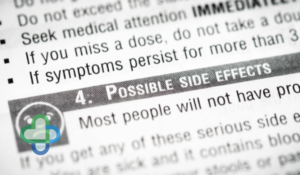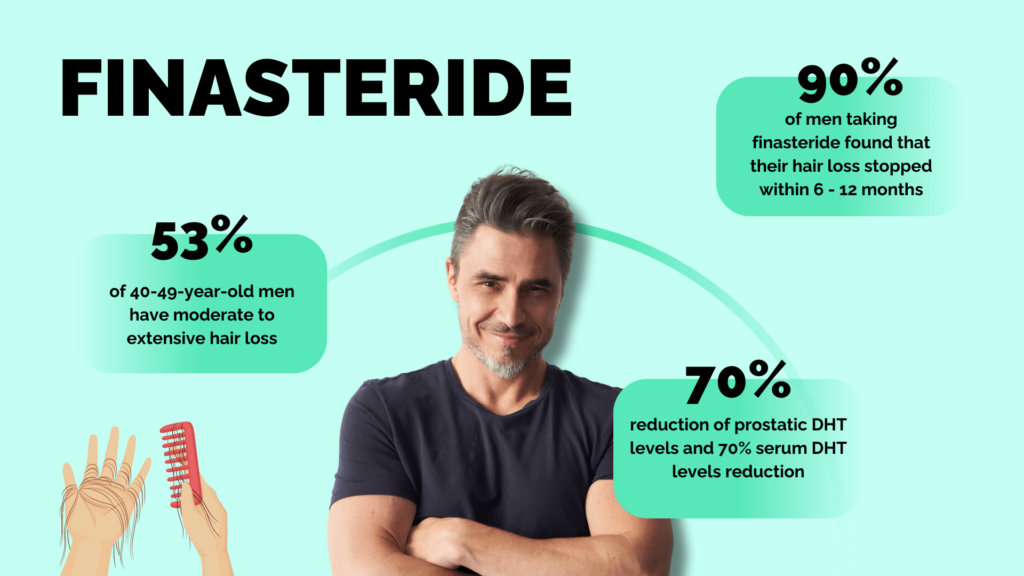
How To Reduce Side Effects Of Finasteride
Table of Contents
Finasteride and its side effects
Written by: Clara Hanson-Smith
Reviewed by: Sunny Dhain MPharmRS PgDip IndP
Date reviewed: 20/02/2024
Finasteride, a medication primarily used for the treatment of male pattern baldness and benign prostatic hyperplasia (BPH), has been associated with a range of side effects, although it is important to note that not everyone taking finasteride will experience these.
The most widely discussed and concerning side effects for many patients are those related to sexual function. These can include decreased libido, erectile dysfunction, and problems with ejaculation. Studies and clinical trials have reported these side effects in a minority of patients, but the occurrences can vary. It’s also important to note that in most cases, these side effects are reversible upon discontinuation of the medication.
Psychological effects
There have been reports of mood-related changes in some people taking finasteride, including symptoms of depression.
Effects on prostate-specific antigen (PSA) levels
Finasteride can decrease PSA levels in the blood, which is a marker used in screening for prostate cancer.
Pregnancy and breastfeeding
Finasteride is not for use in women, particularly those who are or may become pregnant. The medication can cause birth defects in a developing male fetus.
Long-term effects
Research into the long-term effects of finasteride is ongoing. Some studies suggest that side effects may persist even after stopping the medication, but these findings are not conclusive and require further investigation.
Can you reduce the chances of side effects?
Reducing the risk of side effects when taking finasteride, especially for conditions like male pattern baldness or benign prostatic hyperplasia (BPH), involves a few approaches:
Follow the prescribed dosage
It’s crucial to adhere strictly to the dosage prescribed by The Family Chemist’s pharmacist. Do not alter the dose or frequency without consulting them.
Regular monitoring
Regular check-ups with our pharmacist can help monitor any potential side effects.
Awareness of side effects
Being informed about potential side effects helps in recognising them early if they occur. Early detection can lead to more effective management.
Lifestyle factors
While lifestyle factors haven’t been proven to directly influence the side effects of finasteride directly, maintaining a healthy lifestyle (like a balanced diet, regular exercise, and avoiding smoking and excessive alcohol consumption) can contribute to overall health and well-being.
Discuss alternative treatments
If you are concerned about the side effects of finasteride, discuss alternative treatments with our pharmacist. There may be other medications or therapeutic options available for your condition.
Patient education
Understanding the medication, its purpose, and its effects can help make informed decisions and manage expectations.
Report side effects
If you experience side effects, report them to us immediately. We may adjust your treatment plan or provide interventions to manage the side effects.
Counselling and support
For psychological side effects like mood changes or sexual dysfunction, counselling or support groups can be beneficial.
Can you take finasteride every other day or split the tablet to make 0.5mg?
Taking finasteride in a reduced dosage or frequency, such as every other day or splitting the tablet to make a 0.5mg dose, is a topic that has been explored in some studies and clinical practice. These methods aim to maintain the drug’s efficacy while potentially reducing the risk of side effects.
Here are some points to consider:
Every other day dosage
Some studies have suggested that taking finasteride less frequently than daily might still be effective for hair loss, though this might vary depending on individual response. The half-life of finasteride is relatively long, which supports the potential feasibility of less frequent dosing.
Splitting tablets
Finasteride is commonly prescribed in 1mg tablets for hair loss and 5mg tablets for BPH. Some patients choose to split the 1mg tablets to reduce the dose, potentially to decrease the risk or severity of side effects. However, it’s important to note that tablet splitting should be done cautiously and ideally with the guidance of our pharmacist, as it can lead to uneven dosing.
Consulting The Family Chemist’s Pharmacists
Before altering the dose or frequency of finasteride, it’s crucial to consult with our pharmacist. They can provide guidance based on your specific health situation and the current understanding of the medication’s efficacy and side effects.
Pharmacological considerations
The pharmacodynamics of finasteride need to be considered. Even at lower doses, finasteride can significantly inhibit the enzyme 5-alpha-reductase, which is responsible for converting testosterone to dihydrotestosterone (DHT). The relationship between dose, DHT inhibition, and clinical outcomes like hair growth or side effects is complex.
Monitoring response and side effects
If a decision is made to alter the dosing regimen, careful monitoring of the treatment response and any side effects is essential. This can help in adjusting the treatment plan as needed.
Consistency in Finasteride dosing
If a modified dosing regimen is adopted, maintaining consistency in how and when the medication is taken is essential for assessing its effectiveness.
How Finasteride works
Finasteride works by preventing the action of an enzyme called 5-alpha-reductase. This enzyme is responsible for the exchange of testosterone into dihydrotestosterone (DHT). DHT plays an important role in the improvement of male pattern baldness.
In individuals experiencing hair loss, DHT binds to receptors in hair follicles on the scalp, leading to a process known as miniaturization of the hair follicles. This process gradually changes the lifecycle of hair, resulting in thinner, shorter hairs, and eventually may stop hair growth altogether in those follicles.
Finasteride reduces the levels of DHT in the scalp by inhibiting the transfer of testosterone to DHT. This decrease in DHT has been shown to halt the progression of hair loss in many men, and in some cases, it can even lead to regrowth of hair. The effects of finasteride are most noticeable in men with mild to moderate hair loss.
Finasteride FAQs
- What does taking Finasteride do?
Finasteride is used to treat male pattern baldness (androgenetic alopecia) and benign prostatic hyperplasia (BPH), which is an enlargement of the prostate gland. In the case of hair loss, finasteride works by stopping the conversion of testosterone to dihydrotestosterone (DHT), a hormone that contributes to hair follicle shrinkage and hair loss in men. For BPH, reducing DHT helps in decreasing the size of the enlarged prostate, thereby relieving symptoms like urinary retention.
- Is Finasteride a high-risk medication?
Finasteride is generally considered safe for its approved uses, but like all medications, it has potential side effects. The risk profile of finasteride is well-documented and includes potential sexual side effects (like decreased libido and erectile dysfunction), psychological effects (such as depression), and others. However, these side effects are not experienced by all users and are often reversible upon discontinuation of the drug. It is not typically categorised as a “high-risk” medication but should be used under medical supervision.
- Why do men not take Finasteride?
Some men may choose not to take finasteride for various reasons. Concerns about side effects, particularly sexual side effects, are common reasons. Additionally, the idea of taking long-term medication for hair loss or prostate issues might not be appealing to everyone. Personal health considerations, alternative treatment preferences, or advice from our pharmacists might also influence this decision.
- Is Finasteride legal in the UK?
Yes, finasteride is legal in the UK. It is available by prescription from The Family Chemist. This ensures that individuals undergo an appropriate medical evaluation and receive guidance on the use of the medication, including understanding its benefits and potential risks.
Finasteride FAQs
What does taking Finasteride do?
Finasteride is used to treat male pattern baldness (androgenetic alopecia) and benign prostatic hyperplasia (BPH), which is an enlargement of the prostate gland. In the case of hair loss, finasteride works by stopping the conversion of testosterone to dihydrotestosterone (DHT), a hormone that contributes to hair follicle shrinkage and hair loss in men. For BPH, reducing DHT helps in decreasing the size of the enlarged prostate, thereby relieving symptoms like urinary retention.
Is Finasteride a high-risk medication?
Finasteride is generally considered safe for its approved uses, but like all medications, it has potential side effects. The risk profile of finasteride is well-documented and includes potential sexual side effects (like decreased libido and erectile dysfunction), psychological effects (such as depression), and others. However, these side effects are not experienced by all users and are often reversible upon discontinuation of the drug. It is not typically categorised as a “high-risk” medication but should be used under medical supervision.
Why do men not take Finasteride?
Some men may choose not to take finasteride for various reasons. Concerns about side effects, particularly sexual side effects, are common reasons. Additionally, the idea of taking long-term medication for hair loss or prostate issues might not be appealing to everyone. Personal health considerations, alternative treatment preferences, or advice from our pharmacists might also influence this decision.
Is Finasteride legal in the UK?
Yes, finasteride is legal in the UK. It is available by prescription from The Family Chemist. This ensures that individuals undergo an appropriate medical evaluation and receive guidance on the use of the medication, including understanding its benefits and potential risks.





